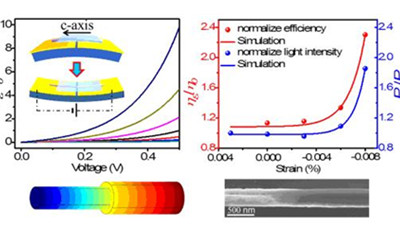
The piezoelectric optoelectronics effect improves the efficiency of organic-inorganic core-shell composite LEDs. The upper left picture in the figure is the current change graph under stress, and the upper right is the change diagram of light intensity and external quantum efficiency with stress. It can be seen that for this device, light intensity and efficiency are significantly enhanced under compressive stress. The two pictures above are the potential distribution under compressive stress and the scanning electron micrograph of the core-shell structure.
The organic / inorganic composite structure UV LED based on ZnO nanowires has attracted widespread attention in recent years because it can not only combine the high flexibility of the polymer and the high chemical and structural stability of the inorganic nanostructure, but also compare to the device composed of thin films. It can also provide higher light extraction efficiency. Organic / inorganic composite LEDs based on ZnO nanostructures have been realized in a variety of polymer material systems, such as poly (3,4-ethylenedioxythiophene) -poly (styrenesulfonic acid) (PEDOT: PSS) , N, N "-diphenylbiphenyldiamine (α-NPD), poly [2-methoxy-5- (2-ethylhexyloxy) -1,4-phenylene vinylene] (MEH -PPV), etc. However, UV LEDs based on ZnO micro-nano structures have so far lacked good methods to achieve a balance of electron and hole currents and reduce non-radiative recombination at the interface, and their external quantum efficiency is very low. In most of the existing literature, there is not even any data report about the conversion efficiency of ZnO nanowire / polymer composite UV LED.
The external quantum efficiency of an LED is the ratio of outgoing photons to injected electrons. Whether the balance of the electron and hole current injected into the LED has a very important effect on the electron-hole recombination efficiency and the external quantum efficiency of the LED. If the current of one carrier is significantly larger than that of the other, a large part of the majority of carriers will not participate in the recombination, so that it only contributes to the current and does not contribute to the light output. Achieving current balance in the preparation of high-efficiency LEDs is a very important key technology. Currently commonly used methods include the use of suitable electrode materials, the use of insulators as carrier barriers, and subsequent processing of polymers. Prof. Zhonglin Wang's research group at the Georgia Institute of Technology and the Institute of Nano Energy and Systems of the Chinese Academy of Sciences reported for the first time in 2011 a new method of using piezoelectric optoelectronics to improve the efficiency of inorganic LEDs based on ZnO nanowires.
This year, through the joint efforts of Dr. Yang Qing, PhD students Liu Ying and Dr. Pan Caofeng, and other researchers in the Wang Zhonglin group, they have achieved the first use of piezoelectric optoelectronics to improve the efficiency of organic / inorganic composite UV LEDs. They first prepared ZnO nanowires / p-type polymer core-shell structures through micromanipulation, and selected appropriate electrodes to form Schottky junctions to initially improve LED efficiency. Then through the piezoelectric optoelectronics effect to further improve the optimized LED quantum efficiency.
The study found that under the appropriate stress, the external quantum efficiency can be increased by more than twice, reaching 5.92%. The asymmetric change of the IV curve under positive and negative bias shows that the improvement of device performance is mainly caused by the piezoelectric effect with polarity, rather than the non-polar piezoresistive and contact effects. Their work was published online in Nano Letters (dx.doi.org/10.1021/nl304163n) This work not only proves that the piezoelectric optoelectronics effect can be expanded from rigid inorganic materials to flexible organic / inorganic composite materials, it provides a new concept to improve the efficiency of organic LEDs, and the adoption of the core-shell structure provides a cheap, simple and efficient UV LED preparation method. The research results have broad application prospects in high-efficiency flexible optoelectronic devices, high-density information storage, military fields, and green energy devices.
Offset Printing Machine can divide into double Color Offset Press , Single color offset press, 56 NPoffset press ,47NP offset press ,Single unit computer bill production line, double-side offset press, collating machine, double color offset Printing Machine etc. all these machine from professional manufacture and they also has good reputation in the market, professional sales and technical service team, which has many years experience in offset press market.
Offset printing machine (offset printing press) is a kind of offset printingmachine, printing and printing from a plate to print to the rubber roller, and then by the rubber roller transfer to paper. Offset printing machine according to different feeding ways, can be divided into the sheetfed andweb offset printing chromatic number; according to a paper to finish can be divided into monochrome, dual color, four - color and multicolor printing machine; according to the maximum paper format printing can be divided into small offset printing machine, six open, four open, and the wholepiece of paper printing machine, in addition to a paper can simultaneously complete the double-sided printing machine printed on both sides. The sheet fed offset printing machine is used for offset printing machine,printing high-grade commercial printing, packaging and printing products,is the mainstream of modern paper printing.

Offset Printing Machine
Offset Printing Machine, Mini Offset Printing Machine, Offset Printing Equipment
Anhui Innovo Bochen Machinery Manufacturing Co., Ltd. , https://www.innovomachines.com